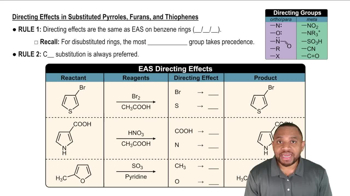Here are the essential concepts you must grasp in order to answer the question correctly.
Electrophilic Addition Reactions
Electrophilic addition reactions involve the addition of an electrophile to a nucleophile, typically across a double bond. In the case of buta-1,3-diene reacting with Br2, the double bond acts as a nucleophile, attacking the electrophilic bromine. This reaction can lead to the formation of different products depending on the stability of intermediates formed during the process.
Recommended video:
Features of Addition Mechanisms.
Stability of Carbocations
Carbocations are positively charged carbon species that can form during reactions involving alkenes. Their stability is influenced by factors such as the degree of substitution (primary, secondary, tertiary) and resonance. In this reaction, the hint suggests that an allylic carbocation, which is stabilized by resonance with adjacent double bonds, may be more stable than the bromonium ion intermediate, affecting the product distribution.
Recommended video:
Determining Carbocation Stability
Temperature Effects on Reaction Mechanisms
Temperature can significantly influence the outcome of chemical reactions by affecting the kinetics and thermodynamics of the process. At lower temperatures, reactions may favor pathways that lead to more stable intermediates, resulting in a higher yield of product A. Conversely, at higher temperatures, the reaction may favor the formation of product B due to increased energy allowing for less stable intermediates to form, thus altering the product distribution.
Recommended video:
Directing Effects in Substituted Pyrroles, Furans, and Thiophenes Concept 2
 Verified step by step guidance
Verified step by step guidance Verified video answer for a similar problem:
Verified video answer for a similar problem:



 7:50m
7:50m